Lifestyle
It’s Time for a Fashion Revolution

This year will be a year of seismic change in fashion. That much is a given.
Or actually, it is a given that this will be a year of seismic change in fashion personnel. Starting this month, new designers at eight global brands, including Calvin Klein and Chanel, will be making their runway debuts. As they will at Bottega Veneta, Lanvin, Givenchy, Tom Ford, Alberta Ferretti and Dries Van Noten — with the possibility of more open spots being filled at Fendi, Maison Margiela, Helmut Lang and Carven in the coming months.
Sheesh! Whether that power shift will translate into seismic change in what we wear is a different question.
There has been much speculation as to the source of the turmoil. Much blame has focused on a slowdown in luxury spending (especially in China), as well as global political and economic uncertainty, which has led to a game of Blame the Designer (when in doubt, blame the designer), which led to Change the Designer.
There is a tendency, in such an environment, to play it safe. To fall back into the comfort of a camel coat and assume that what sold well in the past will sell well in the future. To focus on the commercial over the creative.
This would be a mistake.
It is time for a fashion revolution. The kind of revolution that Coco Chanel created in the 1920s, when she transformed the little black dress, uniform of the serving class, into a status symbol of liberation, apparently causing Paul Poiret to clutch his breast in horror and declare: “What has Chanel invented? Deluxe poverty.” Her clients resembled “little undernourished telegraph clerks,” he sneered.
The kind of revolution that Christian Dior wrought in the postwar era, when he scandalized the world with the New Look, in all its lavishly skirted, wasp-waist glory, inciting riots in the streets against the sheer excess of material. The kind that Yves Saint Laurent ignited during the upheavals of the 1960s, when he adapted the male tuxedo for women, causing Nan Kempner to be cast out of La Côte Basque for the crime of wearing pants.
And the kind that Rei Kawakubo of Comme des Garçons created when she treated darkness and destruction like precious skins as the Cold War collapsed and Francis Fukuyama declared the end of history. Ms. Kawakubo was castigated for promoting “Hiroshima chic,” even as her embrace of the flawed forever shifted ideas about beauty and the body.
Just as, when the millennium turned, Thom Browne was widely mocked for putting grown-up men in short pants (or just plain old shorts) and shrunken jackets. Until those shrink-wrapped gray suits changed not just proportions, but the very meaning of “uniform.”
Such designs horrified and thrilled in equal measure, but they also rose to the challenge of a changed world and a changing sense of how people dressed — not just at the moment they appeared, but forever after.
Fashion is essentially a story of what the paleontologists Stephen Jay Gould and Niles Eldredge called “punctuated equilibrium,” a theory positing that significant change comes in spurts that interrupt lengthy periods of stability or slow evolution. It’s how we got L.B.D.s, the New Look, pants, the possibilities of destruction.
Out of chaos came creativity. That’s where we are now: at a mass inflection point when the world order is in flux, social mores are shifting, the A.I. era is dawning and it’s not clear how everything will be resolved. The first quarter of the 21st century, with the ascent of streetwear and athleisure, is over. There is a hunger for the defining next.
Hence the outsize reaction to the Maison Margiela couture show last January, when John Galliano, then the house’s designer, offered up a phantasmagorical underworld full of exploding flesh and extraordinary tailoring that was so unlike the current made-for-the-’gram runway that it provoked fits of foot-stomping ecstasy in its audience.
Those clothes were not actually new; they were newly dramatized versions of work Mr. Galliano had done before — throwbacks, with their extreme corsetry and theatricality, to late-20th-century fashion fabulousness. It was the applause more than the actual silhouettes (which haven’t remotely filtered out into the general population) that was telling: the clearly voracious appetite for something that didn’t look or feel like all the things that had come before.
It was a sign, if any were needed, that the door is wide-open for someone to stop reinventing history and start inventing; to create the thing we didn’t know we wanted, the thing that is impossible to predict, because, by definition, if you can predict it, it isn’t a surprise.
There are designers who are clearly trying: Demna, with his inversion of luxury semiotics at Balenciaga; Jonathan Anderson, with his surreal craftiness at Loewe. These are designers who twist not just items but proportions. Some of their work has jarred the status quo and produced moments of viral indignation (especially Demna, with his haute Ikea bags and eroded sneakers), but as yet, neither has produced a paradigm shift. Wouldn’t that be something to see?
Here’s hoping the new crop tries, that new names and new brains actually make some new clothes, even if at old houses. Thanks to our wildly connected world, the possibilities for one crazy idea of what it means to look modern, to alter the mass sense of self, are almost limitless.
Here’s hoping they seize the moment not to dutifully respect the so-called codes of the house — enough with the codes of the house — but to embrace the abstract ethos of their brands, not the literal shapes from the archives. Not to merely tweak the mold, but to break it and reinvent it. If outrage is the result that’s not necessarily a bad thing, because it’s often an outrage when you see something that challenges your ideas of proper dress.
But it’s an outrage with a purpose. And if there is another lesson that history offers, it is that such outrage eventually pays off.
Until then, it takes courage for executives and backers to withstand the initial backlash and opprobrium; it takes time for the eye, and wardrobe, to adjust. The problem is that time and forbearance are luxuries rarely offered to designers today. If they are to rise to the occasion, if they are to do the unexpected, they must be granted the space and support to do it.
So c’mon, fashion. Surprise us. Enchant us. Shock us. I dare you.

Lifestyle
In Brooklyn’s Park Slope neighborhood, children’s entertainment comes with strings

The Tin Soldier, one of Nicolas Coppola’s marionette puppets, is the main character in The Steadfast Tin Soldier show at Coppola’s Puppetworks theater in Brooklyn’s Park Slope neighborhood.
Anh Nguyen for NPR
hide caption
toggle caption
Anh Nguyen for NPR
Every weekend, at 12:30 or 2:30 p.m., children gather on foam mats and colored blocks to watch wooden renditions of The Tortoise and the Hare, Pinocchio and Aladdin for exactly 45 minutes — the length of one side of a cassette tape. “This isn’t a screen! It’s for reals happenin’ back there!” Alyssa Parkhurst, a 24-year-old puppeteer, says before each show. For most of the theater’s patrons, this is their first experience with live entertainment.
Puppetworks has served Brooklyn’s Park Slope neighborhood for over 30 years. Many of its current regulars are the grandchildren of early patrons of the theater. Its founder and artistic director, 90-year-old Nicolas Coppola, has been a professional puppeteer since 1954.

The Puppetworks theater in Brooklyn’s Park Slope neighborhood.
Anh Nguyen for NPR
hide caption
toggle caption
Anh Nguyen for NPR

A workshop station behind the stage at Puppetworks, where puppets are stored and repaired.
Anh Nguyen for NPR
hide caption
toggle caption
Anh Nguyen for NPR
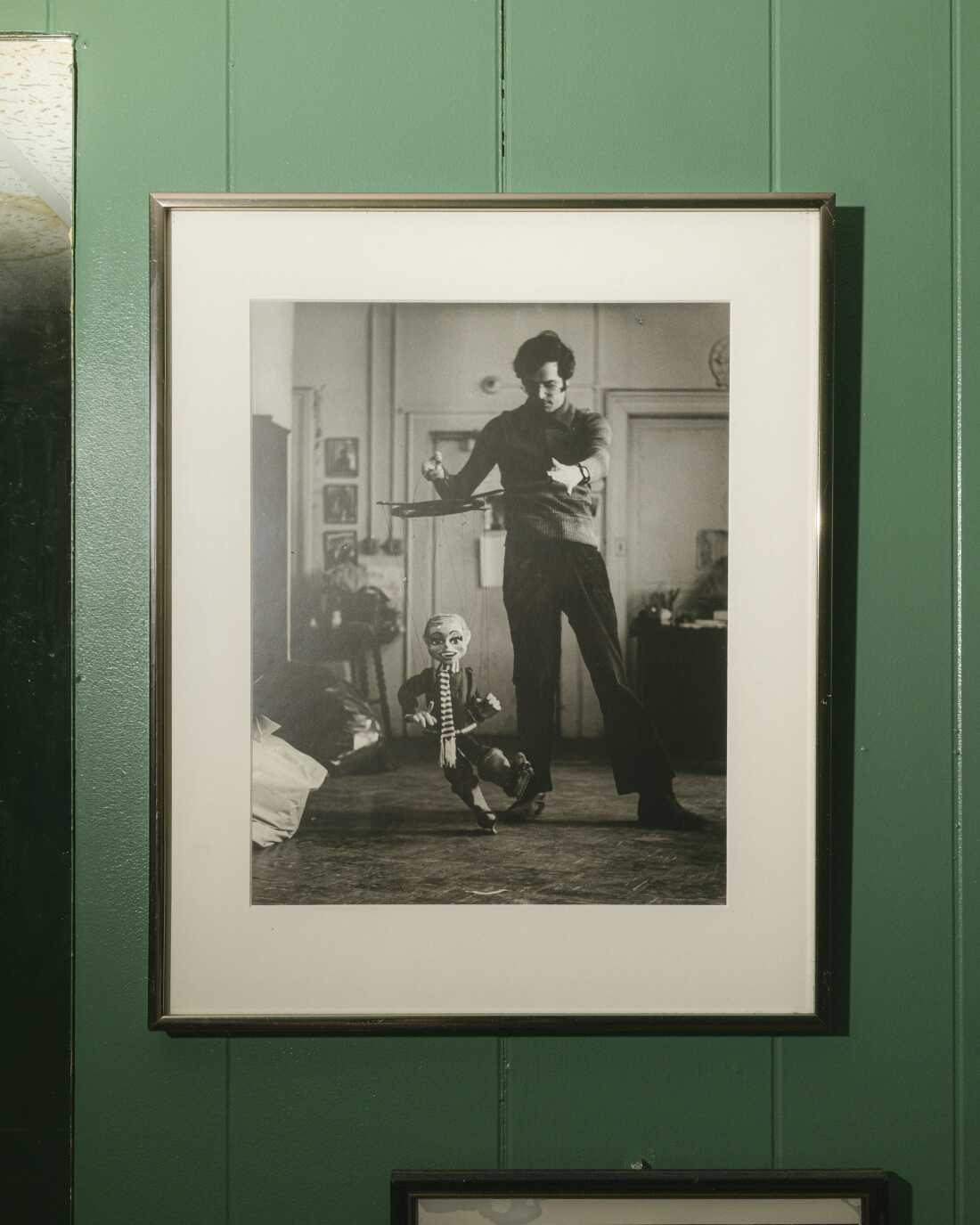
A picture of Nicolas Coppola, Puppetworks’ founder and artistic director, from 1970, in which he’s demonstrating an ice skater marionette puppet.
Anh Nguyen for NPR
hide caption
toggle caption
Anh Nguyen for NPR
For just $11 a seat ($12 for adults), puppets of all types — marionette, swing, hand and rod — take turns transporting patrons back to the ’80s, when most of Puppetworks’ puppets were made and the audio tracks were taped. Century-old stories are brought back to life. Some even with a modern twist.
Since Coppola started the theater, changes have been made to the theater’s repertoire of shows to better meet the cultural moment. The biggest change was the characterization of princesses in the ’60s and ’70s, Coppola says: “Now, we’re a little more enlightened.”

Right: Michael Jones, Puppetworks’ newest puppeteer, poses for a photo with Jack-a-Napes, one of the main characters in The Steadfast Tin Soldier. Left: A demonstration marionette puppet, used for showing children how movement and control works.
Anh Nguyen for NPR
hide caption
toggle caption
Anh Nguyen for NPR

Marionette puppets from previous Puppetworks shows hang on one of the theater’s walls.
Anh Nguyen for NPR
hide caption
toggle caption
Anh Nguyen for NPR

A child attends Puppetworks’ 12:30 p.m. showing on Saturday, Dec. 6, dressed in holiday attire that features the ballerina and tin soldier in The Steadfast Tin Soldier.
Anh Nguyen for NPR
hide caption
toggle caption
Anh Nguyen for NPR
Streaming has also influenced the theater’s selection of shows. Puppetworks recently brought back Rumpelstiltskin after the tale was repopularized following Dreamworks’ release of the Shrek film franchise.
Most of the parents in attendance find out about the theater through word of mouth or school visits, where Puppetworks’ team puts on shows throughout the week. Many say they take an interest in the establishment for its ability to peel their children away from screens.
Whitney Sprayberry was introduced to Puppetworks by her husband, who grew up in the neighborhood. “My husband and I are both artists, so we much prefer live entertainment. We allow screens, but are mindful of what we’re watching and how often.”

Left: Puppetworks’ current manager of stage operations, Jamie Moore, who joined the team in the early 2000s as a puppeteer, holds an otter hand puppet from their holiday show. Right: A Pinocchio mask hangs behind the ticket booth at Puppetworks’ entrance.
Anh Nguyen for NPR
hide caption
toggle caption
Anh Nguyen for NPR
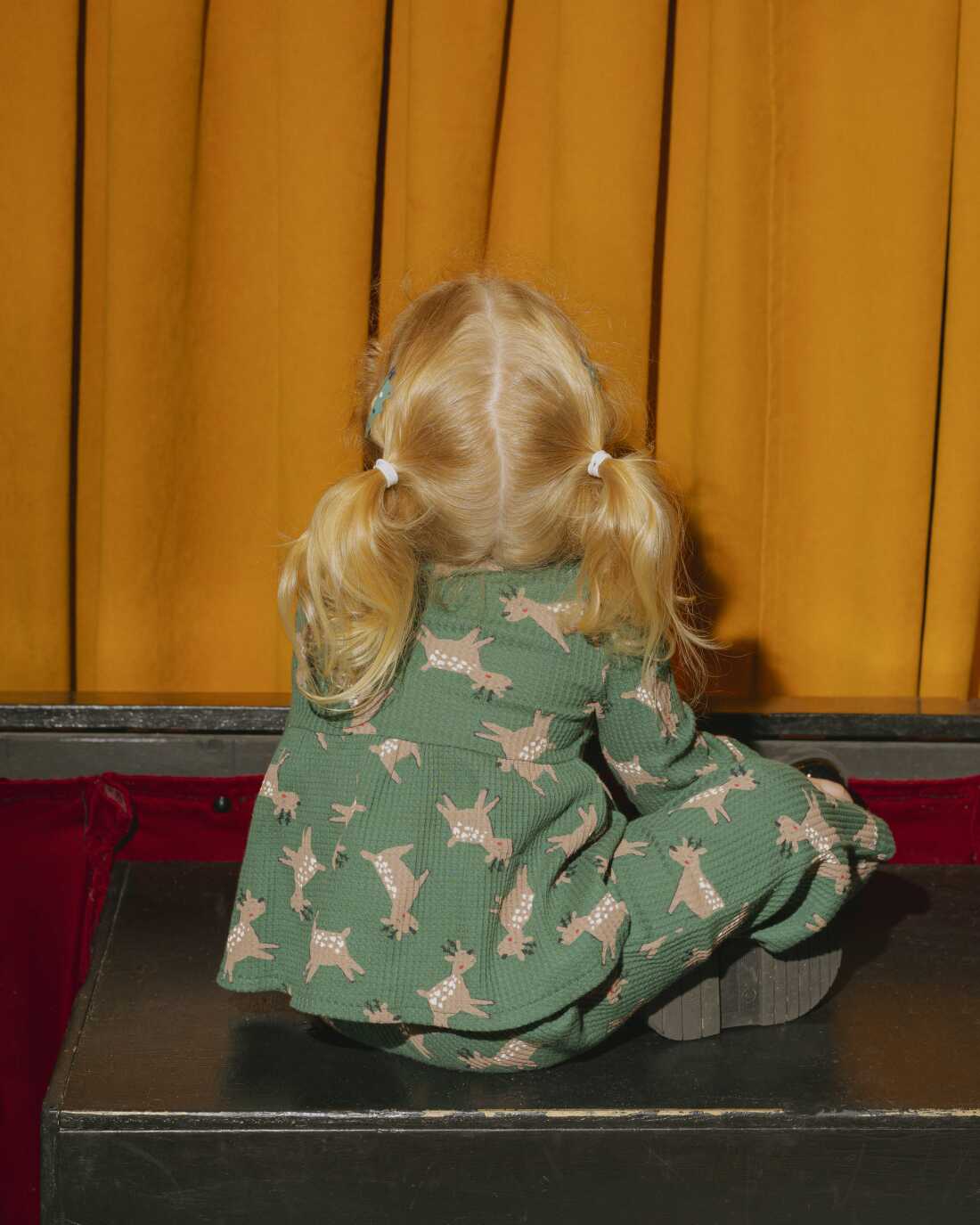
A child attends Puppetworks’ 12:30 p.m. showing on Saturday, Dec. 6, dressed in holiday attire.
Anh Nguyen for NPR
hide caption
toggle caption
Anh Nguyen for NPR

Left: Two gingerbread people, characters in one of Puppetworks’ holiday skits. Right: Ronny Wasserstrom, a swing puppeteer and one of Puppetworks’ first puppeteers, holds a “talking head” puppet he made, wearing matching shirts.
Anh Nguyen for NPR
hide caption
toggle caption
Anh Nguyen for NPR
Other parents in the audience say they found the theater through one of Ronny Wasserstrom’s shows. Wasserstrom, one of Puppetworks’ first puppeteers, regularly performs for free at a nearby park.
Coppola says he isn’t a Luddite — he’s fascinated by animation’s endless possibilities, but cautions of how it could limit a child’s imagination. “The part of theater they’re not getting by being on the phone is the sense of community. In our small way, we’re keeping that going.”
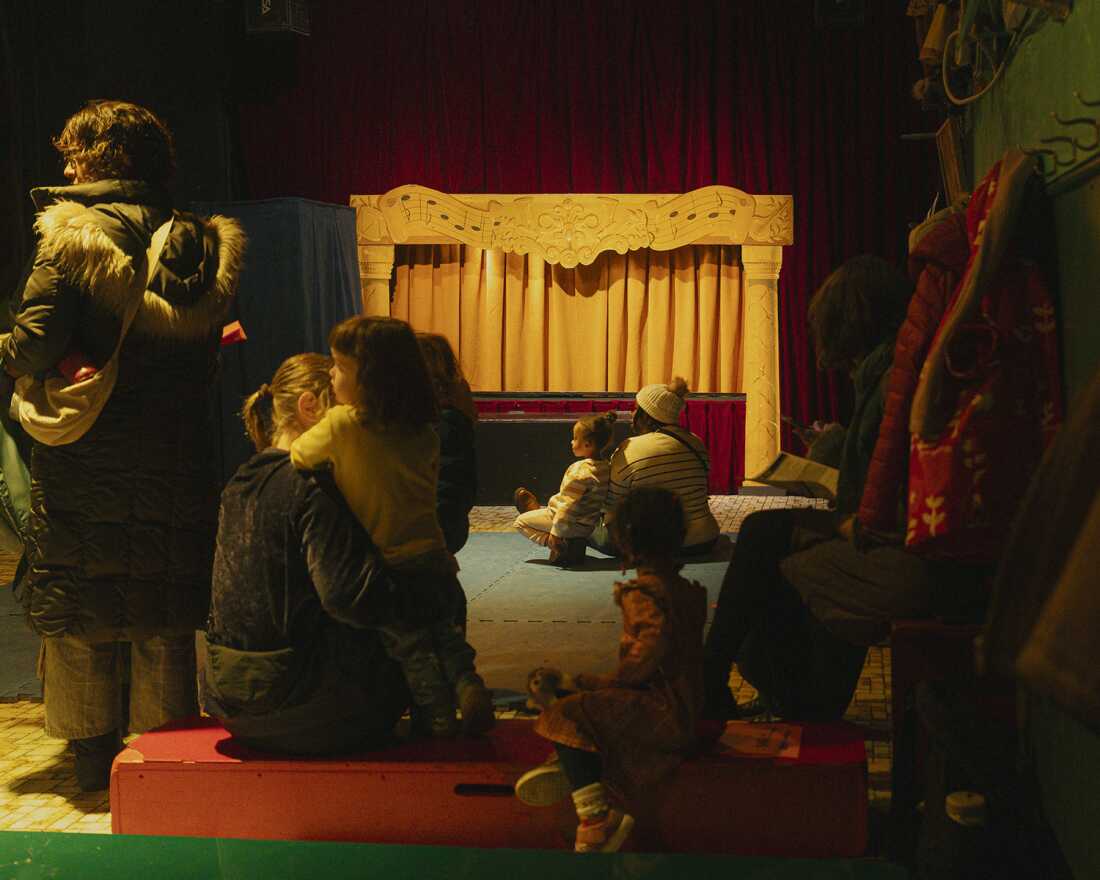
Puppetworks’ 12:30 p.m. showing of The Steadfast Tin Soldier and The Nutcracker Sweets on Saturday, Dec. 6.
Anh Nguyen for NPR
hide caption
toggle caption
Anh Nguyen for NPR
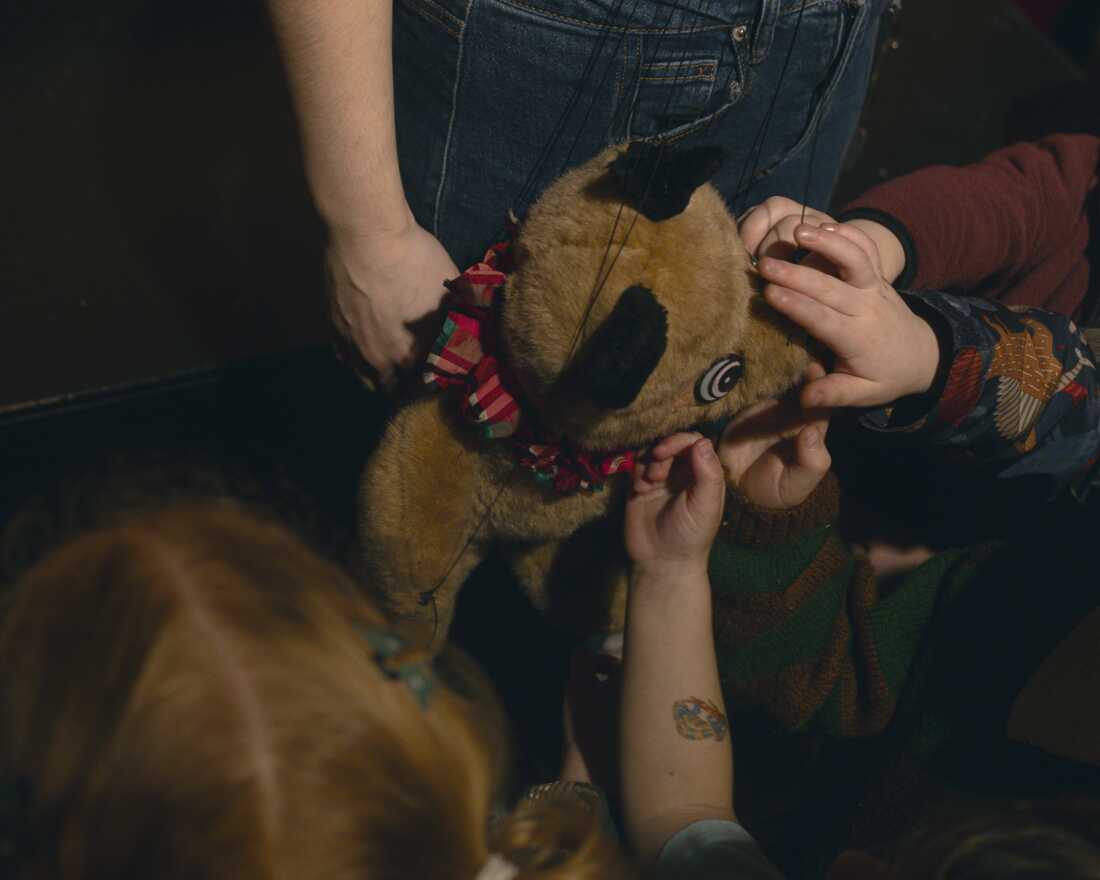
Children get a chance to see one of the puppets in The Steadfast Tin Soldier up close after a show.
Anh Nguyen for NPR
hide caption
toggle caption
Anh Nguyen for NPR
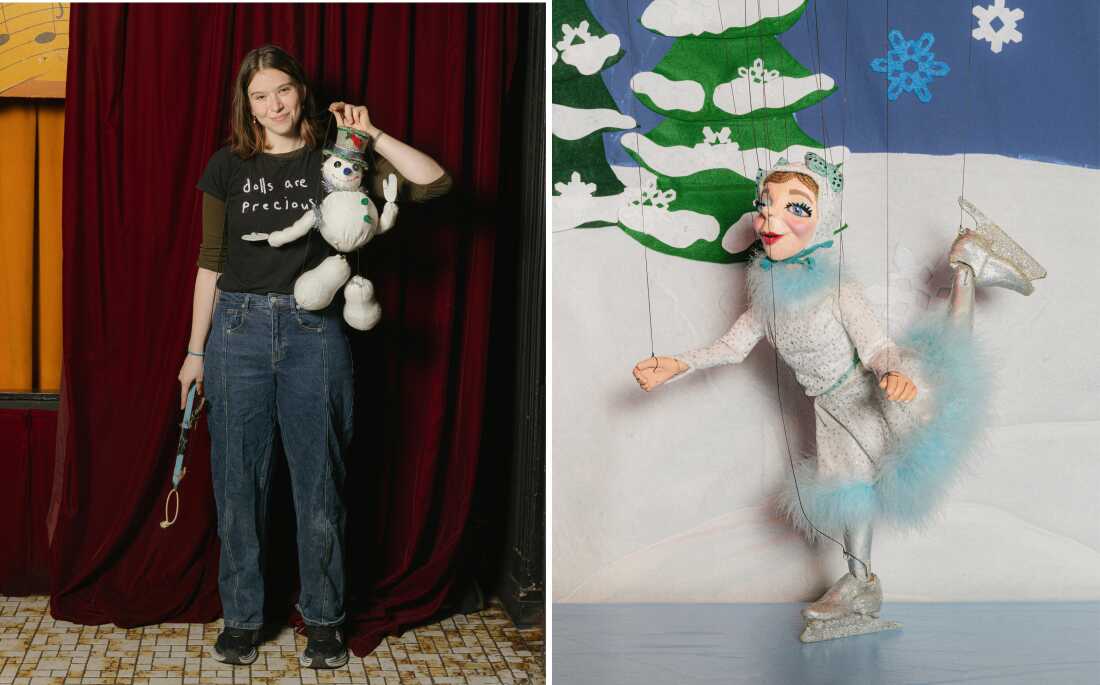
Left: Alyssa Parkhurst, Puppetworks’ youngest puppeteer, holds a snowman marionette puppet, a character in the theater’s holiday show. Right: An ice skater, a dancing character in one of Puppetworks’ holiday skits.
Anh Nguyen for NPR
hide caption
toggle caption
Anh Nguyen for NPR
Community is what keeps Sabrina Chap, the mother of 4-year-old Vida, a regular at Puppetworks. Every couple of weeks, when Puppetworks puts on a new show, she rallies a large group to attend. “It’s a way I connect all the parents in the neighborhood whose kids go to different schools,” she said. “A lot of these kids live within a block of each other.”

Three candy canes — dancing characters in one of Puppetworks’ holiday skits — wait to be repaired after a show.
Anh Nguyen for NPR
hide caption
toggle caption
Anh Nguyen for NPR
Anh Nguyen is a photographer based in Brooklyn, N.Y. You can see more of her work online, at nguyenminhanh.com , or on Instagram, at @minhanhnguyenn. Tiffany Ng is a tech and culture writer. Find more of her work on her website, breakfastatmyhouse.com.
Lifestyle
The Best of BoF 2025: Fashion’s Year of Designer Revamps

Lifestyle
Best Christmas gift I ever received : Pop Culture Happy Hour

-

 Iowa1 week ago
Iowa1 week agoAddy Brown motivated to step up in Audi Crooks’ absence vs. UNI
-

 Maine1 week ago
Maine1 week agoElementary-aged student killed in school bus crash in southern Maine
-

 Maryland1 week ago
Maryland1 week agoFrigid temperatures to start the week in Maryland
-

 New Mexico1 week ago
New Mexico1 week agoFamily clarifies why they believe missing New Mexico man is dead
-

 South Dakota1 week ago
South Dakota1 week agoNature: Snow in South Dakota
-

 Detroit, MI1 week ago
Detroit, MI1 week ago‘Love being a pedo’: Metro Detroit doctor, attorney, therapist accused in web of child porn chats
-

 Health1 week ago
Health1 week ago‘Aggressive’ new flu variant sweeps globe as doctors warn of severe symptoms
-

 Maine1 week ago
Maine1 week agoFamily in Maine host food pantry for deer | Hand Off

























